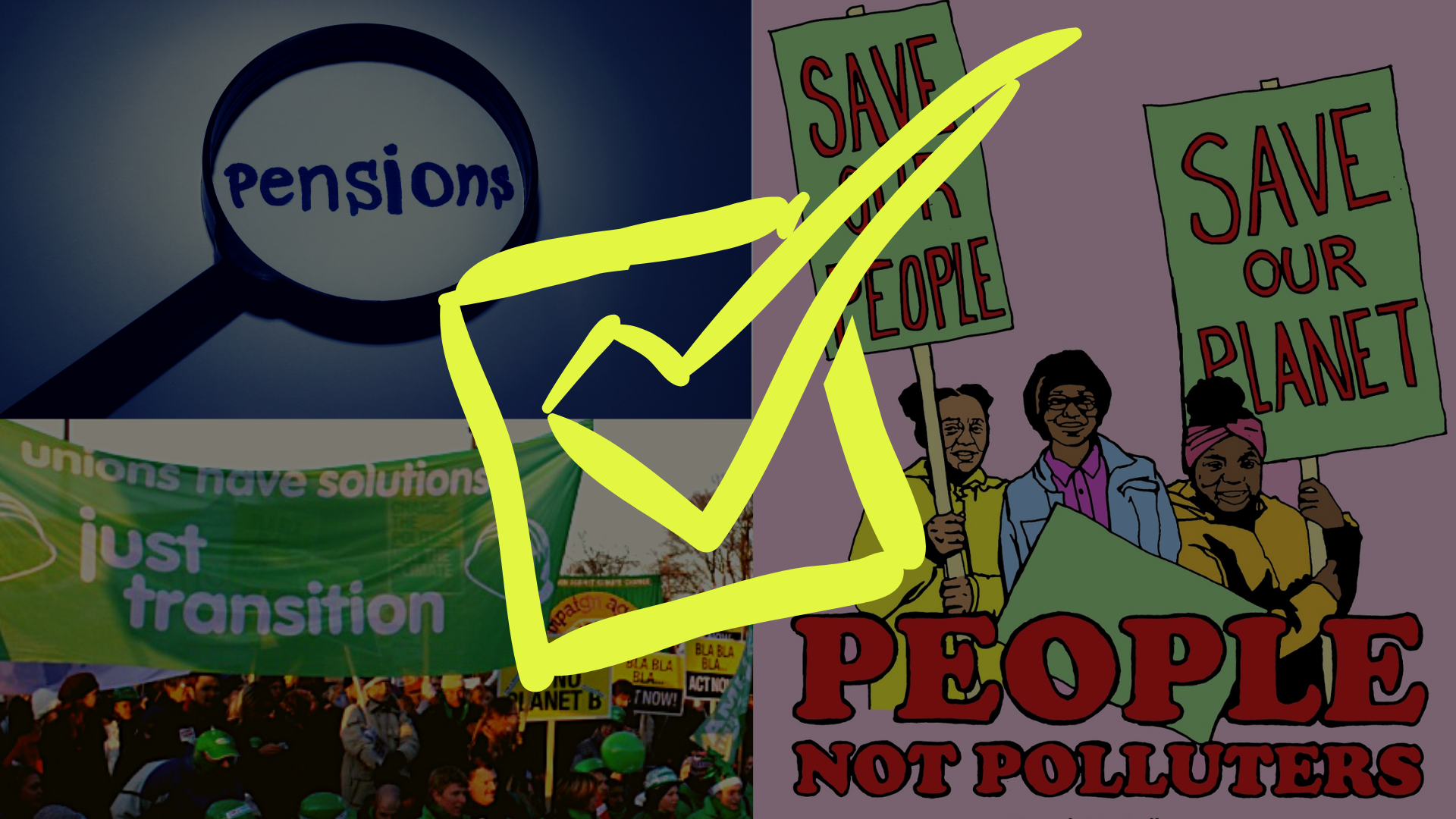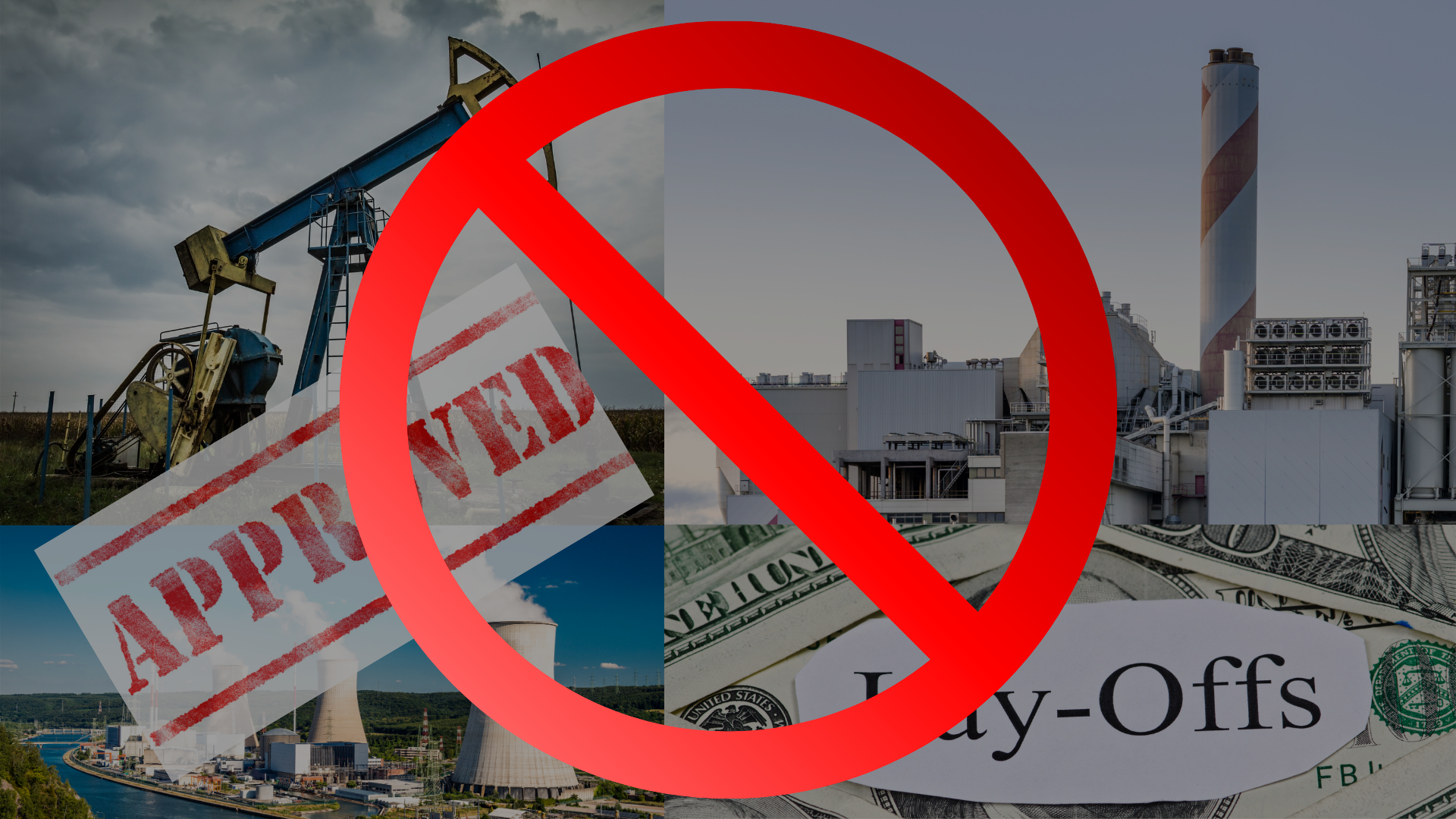Listen to the audio version >>
The climate plan released by Joe Biden in August presents a wide-ranging program for reducing greenhouse gas (GHG) emissions. The previous commentary, “The Biden Climate Plan: Part 1: What It Proposes” summarizes that plan. This commentary identifies the points of conflict on climate policy and related social policies that are likely to emerge within a Biden administration. It concludes by assessing how advocates of a Green New Deal can take advantage of the Biden program to fight for a climate-safe, worker-friendly, socially-just outcome.
Joe Biden doubles down on fracking position: “I will not ban fracking. Period.” Author: The Hill | Watch the video »
The Biden climate plan could lay the groundwork for significant climate-protecting reductions in the burning of GHG-producing fossil fuels. But because it is often quite vague, it could also lay the basis for environmental, economic, and social regression. Which elements of that plan should be supported and which opposed? How can a Biden administration be held accountable to the pledges it has made for effective and job-creating climate policies?
What to Fight For

Advocates of just and effective worker-friendly climate protection will need to fight to hold the Biden administration accountable to his stated climate objectives, including:
Ambitious four-year targets: The Biden plan requires “milestone targets” for 2025 but does not state what they should be. At the least they should reduce GHG emissions at a rate equal to that required to reach the 2050 goal of net-zero emissions.
An effective enforcement mechanism: The Biden plan promises a legally-binding “enforcement mechanism” that will eliminate GHG emissions in the power sector by 2035 and bring all GHG emissions to net zero by 2050. Such an enforcement mechanism must set limits for all GHG emitters. And it must prosecute all emitters who exceed the limits – after all, unless violators are prosecuted, what is the meaning of “legally binding”? Biden’s commitment in this plan is to direct his EPA and Justice Department to “pursue corporations” that “continue to pollute” to the fullest extent permitted by law and to seek additional legislation as needed “to hold corporate executives personally accountable” – including “jail time where merited.”
The plan says Biden will commit that every infrastructure investment that receives federal funding should reduce climate pollution as much as possible. So another enforcement mechanism which has therefore been promised is to refuse federal funding to any program unless proponents can prove that it is reducing climate pollution as much as possible.
Comprehensive executive action: The plan promises that immediately upon taking office President Biden will issue extensive executive orders on climate. He should be presented with plans for all constitutionally permissible executive orders for climate protection.[1]
Effective legislation: The plan demands Congressional legislation within a year and includes many elements that should be in such legislation. However, it is easy to pass legislation that purports to realize specified objectives but in practice won’t actually do so. There are likely to be a lot of fights over inclusion of the elements that are necessary and a lot of proposals that are ineffective, cost-ineffective, or dangerous. It will take fights to ensure that legislation will actually reduce GHG emissions at the necessary rate while maximizing the accomplishment of other GND goals.
Effective institutional vehicles: Recent decades have seen a dismantling of government capacity to realize socially desired goals. The Biden plan says little about the building of public institutions to realize its objectives. For any plans to be effectively implemented they will require governmental structures to realize them.
Make polluters pay: The Biden plan lays out two different though potentially complementary strategies for meeting the costs of climate protection. The first is through an “enforcement mechanism” based on the principle that “polluters must bear the full cost of the carbon pollution they are emitting.” Since the full cost of carbon pollution is by any measure colossal – equivalent to the full current and future damage of climate change – this has the potential to put the entire fossil fuel industry into bankruptcy. No such mechanism is spelled out, but it could involve regulation or natural resource damages of the kind provided under the Superfund law.
To help pay for climate protection, the plan proposes “reversing the excesses of the Trump tax cuts for corporations, reducing incentives for tax havens, evasion, and outsourcing, ensuring corporations pay their fair share, closing other loopholes in our tax code that reward wealth not work, and ending subsidies for fossil fuels.” The United States will cut fossil fuel subsidies in his first year and redirect those resources to investment in clean energy infrastructure.
Whatever the means, the Biden plan proposes to put the cost of climate protection on corporations and the fossil fuel industry, not on ordinary people. While that is extremely positive for popular support and popular economic needs, it will no doubt provoke strong resistance from those who will carry the cost.
Environmental justice: The Biden climate plan includes “environmental justice” in its name and includes significant if somewhat vague measures to realize it. Many of these measures are likely to provoke significant struggle, since they will allocate environmental and economic costs to different groups.
The Biden plan promises to take action against “fossil fuel companies and other polluters who put profit over people and knowingly harm our environment and poison our communities’ air, land, and water, or conceal information regarding potential environmental and health risks.” A Biden administration will “make sure the development of solutions is an inclusive, community-driven process.” It will see that “communities harmed by climate change and pollution are the first to benefit from the Clean Economy Revolution” and that “these communities receive preference in competitive grant programs in the Clean Economy Revolution.” While these promises are quite vague, preference in grants programs provides a specific commitment to which a Biden administration can be held accountable.
No worker left behind: The Biden plan pledges that “We’re not going to leave any workers or communities behind.” It promises coal miners and their families will receive promised pensions and health benefits and that companies will pay more into the black lung benefits program. It will establish a Task Force on Coal and Power Plant Communities to help these communities “access federal investments and leverage private sector investments to help create high-paying union jobs” and “keep public employees like firefighters and teachers on the payroll, and keep local hospitals open.” More broadly, clean energy jobs must offer “good wages, benefits, and worker protections.” President Biden will “defend workers’ rights to form unions and collectively bargain in these emerging and growing industries.” While these commitments are rather vague, they offer points on which demands made on a Biden administration will be legitimated by Biden’s own plan.
What to Fight Against

Photo credit: Just Transition Rally, CC BY-SA 2.0, Marc Kjerland / Flickr
The Biden plan potentially opens the door to some policies that could do great harm to people and the environment; fail to significantly restrict GHG pollution; and/or divert vast amounts of money to boondoggles that enrich proponents but do little to reduce climate destruction.
Nuclear energy: One of the items in the Biden plan’s research agenda is “small modular nuclear reactors.” It does not give an endorsement to deployment of nuclear reactors, however. Rather, it starts by making the broad point that, to address the climate emergency we must look at “all low- and zero-carbon technologies.” The Biden ARPA-C program will look at issues “ranging from cost to safety to waste disposal systems” that remain an “ongoing challenge with nuclear power today.” An objective evaluation of these “challenges” is almost certain to conclude that cost, safety, and waste disposal make nuclear energy a far worse option than renewable energy and energy efficiency. But because there is a powerful industry behind it and powerful advocates for it, a fight will be necessary to ensure that huge sums are not squandered on nuclear and other technologies that threaten human and environmental well-being at a far higher cost than renewable technologies.
Carbon capture and storage: For decades, those who seek to gain through perpetuation of the fossil fuel economy have advocated technologies, known by such names as “carbon capture and sequestration” (CCS) and “carbon capture, use, and storage” (CCUS), that they claim can reduce GHG emissions without reducing the burning of carbon. The idea is simple: go on burning carbon, but somehow capture it before it leaves the smokestack and gets into the atmosphere. Governments have already spent substantial sums on subsidizing experiments with such schemes, but there is little evidence that they will soon be commercially viable, let alone competitive with renewable energy. Indeed, capturing carbon in itself squanders large quantities of energy. Nonetheless the Biden plan proposes to “double down on federal investments and enhance tax incentives for CCUS” as well as to fund “carbon capture research, development, and demonstration.” As with nuclear power, huge sums can be squandered on carbon capture that could be used for far more cost-effective climate protection strategies. And meanwhile the illusion of “clean carbon” can continue to be used to persuade policymakers and the public that there is no need to reduce the burning of carbon – CCUS will simply suck it up and dispose of it. Except for basic research, expenditure on carbon capture should be halted unless there is proof that it can be cheaper, safer, and better for the climate than renewable energy and energy efficiency.
Permits to pollute: The Biden plan does not advocate carbon cap and trade policies, purchase of carbon offsets, and other strategies based on selling permits to pollute. It does mention favorably three examples which claim to provide disincentives for GHG pollution without requiring it to be reduced, including: an Oregon cap and trade proposal; California’s cap and trade system; and the northeastern states Regional Greenhouse Gas Initiative. It also mentions energy taxes as a way to reduce emissions. Such plans for “putting a price on emissions” by requiring a payment by polluters have played a prominent role in some other climate proposals, and there may well be efforts to give them a central role in Biden’s policy, even though they are not included in the current Biden climate plan. There is strong evidence that simply requiring GHG polluters to purchase permits in order to go on polluting has been ineffective in significantly reducing emissions. Such programs should not be allowed to replace the Biden plan’s crucial promise of legally binding enforcement of GHG emission limits that will reduce emissions to net-zero by 2050.
There is plenty of reason to doubt that nuclear, carbon capture, or any other energy technology is superior to renewable energy and energy efficiency if cost, safety, and waste disposal are fully taken into account. The Biden plan pledges to “support a research agenda through ARPA-C to look at issues, ranging from cost to safety to waste disposal systems, that remain an ongoing challenge with nuclear power today.” Such a consideration of all issues of cost, safety, and waste disposal should be included in the evaluation of all proposed energy systems.
Almost any goal or policy can serve as a misleading justification for costly, dangerous programs like nuclear power; costly, ineffective investments like CCS; and costly, futile market-tweaking strategies like cap-and-trade. Such programs will find well-funded advocates. They need to be fought as obstacles to achieving the goals of the Biden climate plan.
The Struggle Ahead
Fracking is bad, actually
— Alexandria Ocasio-Cortez (@AOC) October 8, 2020
The Biden climate plan pledges to “take action against fossil fuel companies and other polluters who put profit over people and knowingly harm our environment and poison our communities’ air, land, and water, or conceal information regarding potential environmental and health risks.” Biden promised that the Biden for President campaign would “not accept contributions from oil, gas and coal corporations or executives.” (The Biden plan did not promise this pledge would apply to the rest of the Democratic party as well.)
Despite their limitations, the measures proposed in the Biden plan would likely make the already-threatened fossil fuel industry unprofitable and put much of it into bankruptcy. Any serious effort to implement such measures will therefore have to take into account the pushback from the industry, the fear and actuality of broader social disruption the measures may bring, and the likely need to take over and run the bankrupt fossil fuel industry with a managed decline until full replacement by clean energy is accomplished. While it is hard to think of historical comparisons on this scale, the abolition of slavery and prohibition of the sale of alcohol come to mind. For the fossil fuel industry this will be a life-and-death struggle.
This struggle will require fighting claims that false solutions like nuclear energy, CCS, and carbon markets will actually work, and that other, more effective measures will have to wait until these new techniques are available and deployed. While each of these false solutions has its own downsides, the primary objective of opposing them is to prevent them from stalling more effective climate protection.
Passing and implementing the positive parts of the Biden climate program is likely to require overcoming opposition to almost every element. The struggle will take place not only in Congress and the Administration, but also in the government bureaucracy, the courts, the regulatory process, the polling places, and the streets. It will be fought at the municipal, state, and national levels. The people threatened by climate change are the one force which, if mobilized, can counter the power of the fossil fuel industry in those arenas.
[1] For details see Kassie Siegel and Jean Su, “Legal Authority for Presidential Climate Action,” Center for Biological Diversity, December, 2019. https://www.climatepresident.org/Legal-Authority-for-Presidential-Climate-Action.pdf

